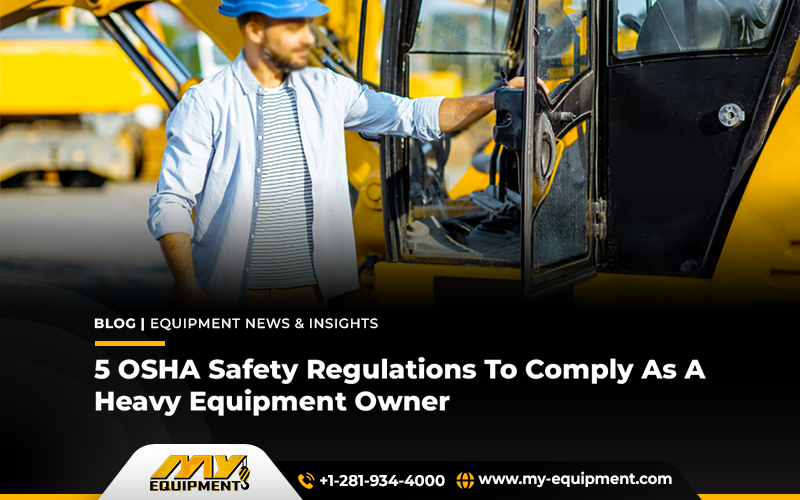Managing heavy construction equipment onsite is dangerous, especially if safety regulations are not defined. For equipment owners to understand and integrate safety regulations, the Occupational Safety and Health Administration has released the most common safety violations and tips to overcome them.
Let’s take a deeper look into the 2024 OSHA regulations to manage heavy equipment on-site safely with problems and relevant safety management solutions;
1. Fall Protection – (1926.501)
One of the most frequent safety hazards is the falling off of an operator from heavy machinery. Generally, construction falls are due to;
- Slippery construction ground
- Improper protection to prevent falling
- Hidden pats or trenches
- Collapsing support
- Unanchored flooring
- The poor condition of the ladders
- Excessive clutter on the construction site
- Missing guardrails
Fall injuries are the main culprit taking the lives of many laborers. Therefore, all heavy equipment owners must maintain a secure and well-aware work regime.
Tips For Fall Protection
To prevent your workforce from falling off opt for the following;
- Make sure employees are equipped with a quality harness
- Adhere to complete maintenance of the worksite in terms of cleaning dirt and other materials
- Facilitate workers with proper personal protective equipment
- Mend wet floors immediately
- Provide protection support in areas near potential falls
2. Ladders (1926.1053)
Since heavy equipments are giant and construction operations involve heights, workers need to climb high. For that purpose, you need to provide employees with a ladder. Oftentimes, ladders are poorly maintained or have weak steps which makes labor prone to uncertain injuries.
Tips To Prevent Ladder-Based Injuries
Follow the mentioned below tips to cope with poorly maintained ladders;
- Regular inspection of ladders to find defects
- Educate employees regarding the safe usage of ladder
- Install ladders of premium quality that can withstand high loads
3. Scaffolding (1926.451)
If scaffolding is poorly designed then workers get prone to injuries. It can lead to insufficient planking, material falling, slippery ground, and improper fall revision stage.
Tips To Overcome Scaffolding Errors
Mentioned below are the tips to mitigate risks related to poor scaffolding structure;
- Go through and imply regulations according to OSHA scaffolding standards for weight limitations, decking, and planking
- Train relevant workers about proper designing and construction of scaffolds
- Conduct regular inspections of scaffolds
- Dont neglect damaged sections and fix them immediately
4. Fall Protection – Training (1926.503)
To comply with OSHA safety regulations, you need to train your staff to overcome falling incidents from heavy equipment. You need to give training to each laborer who is prone to similar hazards.
Through proper training, your employees can learn how to identify and mitigate similar safety hazards.
Following are the systems that you must include while training your employees, they should be aware of the proper usage of;
- Personal fall arrest mechanism
- Warning line operations
- Safety net operation
- Guardrail system
- Controlled access to safety zones
Tips To Include In Fall Training
Heavy equipment operators are prone to hazardous situations which is why they must know what to do in times of trouble.
Therefore, to keep all your staff safe you must educate them on the do’s and don’ts of construction site safety compliance.
5. Eye & Face Protection (1926.102)
Since construction is generally outdoor, workers are vulnerable to flying particles. It ranges from dirt particles to hazardous chemicals. Therefore, all your workers must be protected with safety glasses to protect their eyes and other exposed body parts.
Tips For Face And Eye Protection Onsite
Mentioned below are the tips to extend the safety radar on your construction site especially when heavy construction equipment are running;
- Educate employees regarding the covering of the face and eyes during the usage of heavy construction equipment outdoors
- Equip quality safety goggles, gloves, face shields, laser-safe eye lenses and welding helmets
- Put all the supervisors on alert to ensure all workers are equipped with proper safety gadgets
The Bottom Line
As per today’s limited labor market, one of the most expensive resources is to hire and retain construction field labor. Parallely, as a field incharge you need to obey OSHA regulations for the safe usage of heavy equipment and prevent unnecessary injuries. In addition, when you create a safety culture employees feel heard and secured.
Nonetheless, through all the above mentioned tips you can decrease fatal injury rates, reduce legal safety fines, avoid company defamation, and increase the employee retention rate for your company.


 1400 Broadfield Blvd, Houston, TX 77084,
USA.
1400 Broadfield Blvd, Houston, TX 77084,
USA.